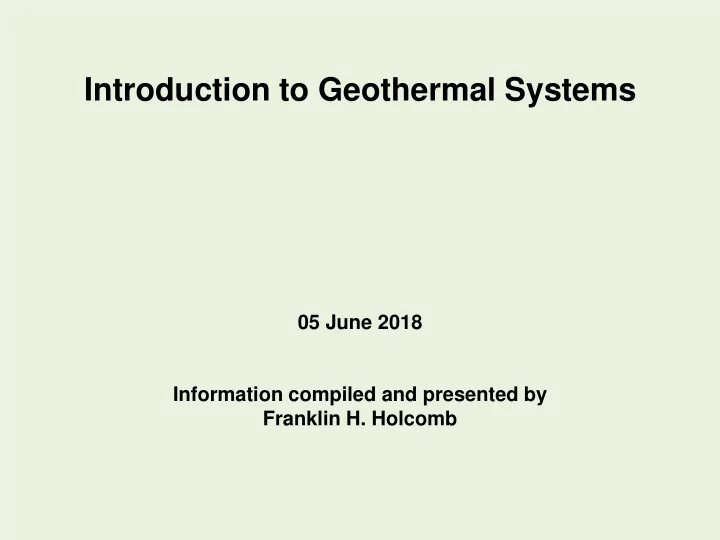

Introduction to Geothermal Systems 05 June 2018 Information compiled and presented by Franklin H. Holcomb
Information Sources U.S. Department of Energy https://www.youtube.com/watch?v=y_ZGBhy48YI Geothermal Alliance of Illinois (GAOI) www.gaoi.org/ https://www.gaoi.org/wp-content/uploads/2013/11/Introduction- to-Geothermal-Comfort-Systems-Dave-Buss-GAOI-Northern- Meeting-10-30-13.pptx Professor Scott Willenbrock (UIUC) https://physics.illinois.edu/outreach/zero-net-energy- house/geothermal U.S. Department of Defense https://www.serdp-estcp.org/News-and-Events/Blog/Coupling- Geothermal-Heat-Pumps-with-Underground-Thermal-Energy- Storage-EW-201135 2
Introduction to Geothermal Comfort Systems 3
Heat Pumps • Heat pumps “move” energy from one location to another, instead of creating heat by burning fossil fuels, such as a gas furnace does. -- (like your refrigerator). • Geothermal Heat Pumps use the earth or well water to provide heating, cooling and hot water for your home. • A geothermal heat pump “moves” energy to/from the ground, eliminating the outdoor equipment associated with ordinary heat pumps or air conditioners. 4
The Basic Ground Source Heat Pump System • The earth loop is placed in the ground either horizontally or vertically, or it can be placed in a pond. • Water and anti-freeze is circulated through the pipe, transporting heat to the heat pump during the heating mode and away from the heat pump during the cooling mode. • The heat transfer takes place inside the heat pump in a water-to-refrigerant heat exchanger. 5
Energy Source • During the heating season, the earth serves as a heat source. (HE - Heat of extraction) • During the cooling season, the earth serves as a heat sink. (HR - Heat of rejection) 6
Heating Mode Operation 7
Cooling Mode Operation 8
Free Energy • Geothermal Heat Pumps use only a small amount of energy to capture a large amount of FREE energy from the earth. 9
Geothermal Performance Comparison Cooling Efficiency (EER) 30 25 New Geothermal Unit 20 Previous Geothermal Unit 15 High Efficiency AC or Heat Pump Ordinary Air Conditioner or Heat 10 Pump 5 0 10
Geothermal Performance Comparison Heating Efficiency (COP) 5.0 4.5 4.0 New Geothermal Unit 3.5 Previous Geothermal Unit 3.0 Heat Pump 2.5 High Efficiency Gas/Propane 2.0 Furnace 1.5 Ordinary Gas/Propane Furnace 1.0 0.5 0.0 11
Operating Cost Comparison Annual Heating, Cooling & Hot Water costs for typical 2,500 sq. ft. home, local weather, local fuel rates (computer analysis results) Geothermal $ 780 High Efficiency Nat. Gas & A.C. $ 1,497 Air Source Heat Pump $ 1,608 High Efficiency Propane & A.C $ 2,305 12
30% Tax Credit* The Bipartisan Budget Act of 2018, signed in February 2018, reinstated the tax credit for fuel cells, small wind, and geothermal heat pumps. The tax credit for all technologies now features a gradual step down in the credit value. Geothermal heat pumps • 30% for systems placed in service by 12/31/2019 • 26% for systems placed in service after 12/31/2019 and before 01/01/2021 • 22% for systems placed in service after 12/31/2020 and before 01/01/2022 • There is no maximum credit for systems placed in service after 2008. • Systems must be placed in service on or after January 1, 2008, and on or before December 31, 2021 • The geothermal heat pump must meet federal Energy Star criteria • The home served by the system does not have to be the taxpayer’s principal residence *Source: http://programs.dsireusa.org/system/program/detail/1235 13
Return on Investment (Due to Energy Savings) • New Homes: Typically positive cash flow from “day one”. – Added cost in mortgage is offset by reduced monthly operating cost. • Existing Homes: Additional cost of geothermal system is usually recovered in about 5 years. 14
Environmental Aspects • Geothermal generally more efficient, but may use more electricity • Carbon offsets dependent upon application and regional “mix” of generation 1 1 e.g. Frank’s 90% furnace and natural gas use ~ 15,400 lbs CO 2 /year, • Geothermal may and total household electric use ~ 13,500 lbs CO 2 /year increase emissions in some cases Need to do the calculations to determine if geothermal will decrease or increase CO 2 emissions 15
Loop Types • Closed Loop (w/ antifreeze) – Horizontal – Vertical – Pond • Open Loop – Well Water 16
Horizontal Loop 17
Slinky 5- 6 feet 10 ft. 2-3 feet Typically 3 or 4 trenches, 100-150 feet long each 18
Horizontal Slinky Loops 19
Side View Vertical Loop 5- 6 feet Typically 3 to 5 bore 120 – 150 feet holes, 130 feet deep 10 – 15 feet each 20
Vertical Loop Drilling Use drilling rig like ones used for water well drilling. 21
Typical Closed Loop Equipment and Accessories 22
Typical Installation 23
Questions? 24
Recommend
More recommend